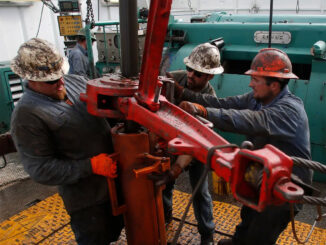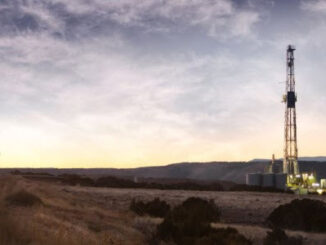
The Texas Railroad Commission, which regulates the state’s oil and gas industry, has obtained a no-fly zone in the area of what it says is an uncontrolled well in Crane County where its crews are working to control the flow of super-salty water erupting from beneath the surface.
The commission said in a statement that it was working to mitigate the “uncontrolled water flow” that was first reported on Dec. 7. Since then, it said it has been working to contain it using vacuum trucks and pits and is researching oil and gas well files to identify the source of the water.
The eruption is the latest sign that water is running amok underground in aging oil fields just north of Fort Stockton. Water under pressure can travel underground — at times carrying radioactive elements, chemicals and other oil field waste — until it finds the path of least resistance, often an unplugged well that can allow it to burst to the surface.
ZOMBIE WELLS: How forsaken oil wells are causing environmental chaos across Texas
The flight restriction, which extends 3,000 feet high and covers 3 nautical miles, was issued to deter a drone pilot from flying in the area, according to a spokeswoman for the commission.
“A drone pilot was flying a drone dangerously close to crews and equipment, thus the no-fly zone was requested for the safety of personnel on location,” she said.
Sarah Stogner, a nearby resident and a vocal critic of the Railroad Commission, said the drone that provoked the restriction was hers and denied that she was flying it too close.
“I wasn’t flying over any people and I was at least 30 to 40 feet above all the equipment,” she said. “I definitely was not a danger to any people or property.”
WHAT TO KNOW: 5 disturbing takeaways from the Chronicle’s investigation into Texas zombie wells
Stogner said she felt compelled to document the problem.
“I think it’s important that people see,” she said. “It’s one thing to hear about it, but it’s another thing to see.”
Bill Burch, a drilling engineer and well control expert who is running for a seat on the Railroad Commission, said the developments in Crane County mark a grave milestone.
“This is the first known irrefutable proof that saltwater disposal in the Permian Basin has brought pressure to surface without any well bore tied to it,” he said. “Which is why it’s so significant. We always figured we were a decade or more away from this scenario.”
He said he suspects the problem began with a geyser that sprung up last year roughly 400 yards away from the more recent eruption. When attempts were made to plug that well, the water likely moved on in search of another path to the surface, he said.
“These are symptoms of the greater cancer,” Burch said. “And all the Railroad Commission can do is play whack-a-mole without dealing with the actual cancer below.”
CHRIS TOMLINSON: Zombie wells haunt 21st century’s clean energy transition and permitting reform
There has been no gas detected in the area, according to the Railroad Commission, noting the no-fly zone request with the FAA cited “gas leak” because it was “the closest criteria” available on the request form.
“The FAA does not have a specific option for the type of work being done at the location,” the spokeswoman said. “Again, no gas has been detected.”
The FAA said in a statement that it approves temporary flight restrictions based on information provided by the government agency requesting them, citing wildfires, space operations and natural disasters as examples. “We base the decision on information the requesting agency provides.”
ENB Top News
ENB
Energy Dashboard
ENB Podcast
ENB Substack



